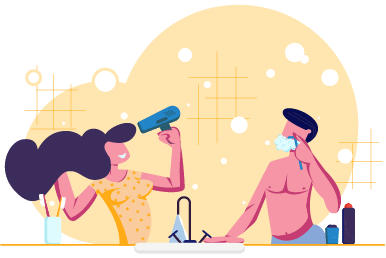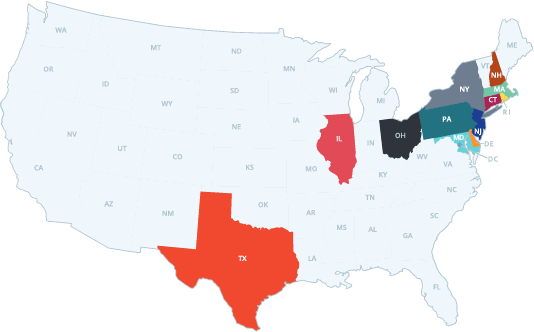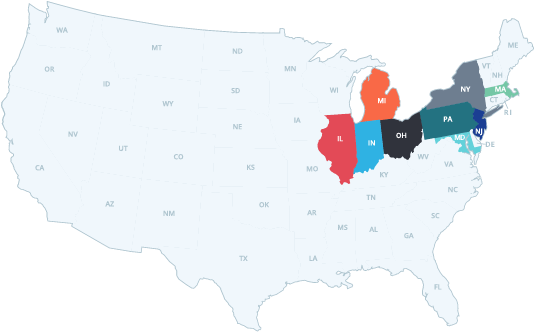How to Save Water in Your Home
A convenient supply of clean, fresh water is an essential element of modern living. We rely on water every day for cooking, cleaning and basic sanitation, and we would not be able to operate our households for long without it. Fortunately, flowing water is available at the turn of a faucet or spigot; however, there are consequences to running your sinks, showers and appliances carelessly. You need to pay for that water through your utility supplier, and your household consumption also creates wastewater which can be harmful to the environment.

So how can you reduce water usage in a way that gives you enough water to continue your life in a responsible manner? Read on for tips on how to save water at home without compromising your health or comfort.
Low Flow Tub and Shower Tips
- While soaking in a nice warm tub might be relaxing, taking a bath every day uses lots of water – the tub can hold 70 gallons or more. Showering uses less water, provided you restrict your showers to a reasonable length - a five minute shower uses between 10 and 25 gallons of water.
- Save water by taking a shorter shower. Leave a timer in the bathroom to help the entire family keep those showers short and sweet.
- If you prefer bathing, only fill the tub to one-quarter full. You’ll still be able to enjoy a relaxing soak while reducing your water consumption by dozens of gallons.
- Install a low-flow shower head and faucet aerators. Many come with a convenient shut-off button that let you save water while you lather up, before switching back to the full stream to rinse the soap away.
- Insulate the hot water pipes in your home to keep the water warmer for longer, which will reduce the amount of time you need to let the water run before your shower while you wait for it to heat up. To be truly economical with your shower, fill a cleaning bucket with the initial surge of water and use it for cleaning chores later on.
- If you’re really in a pinch, keep the bucket under the water for the entirety of your shower. You can use the water you collect to flush the toilet or perform other tasks that don’t require perfectly clean liquid. Just be careful not to trip over the bucket while you’re showering.
- Turn off the water when you brush your teeth. There’s no reason to leave the faucet running for the two minutes of recommended brushing. Instead, only turn water on when you need it to rinse.
- When shaving, fill the sink partway with water and use that to keep the razor clean instead of leaving the faucet running.
- Minerals deposits from water can clog shower heads causing them to dribble, but periodically soaking your showerhead in vinegar will remove the deposits. Pour the vinegar into a plastic bag then immerse the showerhead inside while tying the bag to the shower pipe with a long twist tie. Let it soak all day while you're at work.
Save Water in Your Toilet
- Toilet flushes consume one-third of household water, using anywhere from 1.6 to 3.6 gallons per flush. Multiply that by the number of times your family answers a call of nature, and the amount adds up quickly. Consider instituting an “if it’s yellow let it mellow” policy to reduce the number of flushes your toilets experience per day.
- Don’t flush anything but waste and toilet paper. Not only does it waste water to flush away cotton swabs, dental floss or hair clumps, it can also clog your sewer lines. Toss this stuff into a bathroom wastebasket instead.
- Toilets have moving parts that wear out. The flapper valve that opens for water to flow into the bowl can develop tiny leaks along its seal. If you hear your toilet filling without having been flushed, this valve could be leaking. One way to test it is to put a few drops of food coloring into the toilet tank water and then wait for 10-15 minutes. If you see the colored water in the toilet without flushing, then the flapper valve ought to be replaced to avoid wasting water.
- Experiment with the minimum amount of water you need per flush. The easiest way to do this is to set a water-filled bottle, plastic bag or even a couple of bricks inside the toilet tank to displace the water level. That way, it flushes with a little less water. Beware – if you reduce your water level by too great a volume, you might find that you need multiple flushes to finish a job, which defeats the purpose.
- Dual-flush toilets use far less water than regular toilets because they use different means to flush away liquid and solid waste. They require routine maintenance, so if you own one, it's best to follow the manufacturer's recommended schedule.
Water Conservation in the Kitchen
- Recycle your cooking water. Liquid that you use to boil pasta, beans and other food is perfectly good for watering your household plants. Just make sure the water has enough time to cool down before you start applying it to your plants.
- Don’t run your faucet constantly if you hand wash your dishes. Instead, soak the dishes and wipe them off first, then only turn the water on to rinse off the soap.
- Better yet, use a dishwasher, which in most circumstances uses significantly less water than hand washing.
- Use the water conservation settings on your dishwasher to cut back even further on your water consumption. If your dishwasher doesn’t offer an efficiency setting, consider investing in a new ENERGY STAR labeled model.
- Make sure the dishwasher is close to full before you run it. That way you get more clean dishes per gallon of water you use.
Save Water in the Laundry Room
- Laundry soaks up 20 percent of your home's water usage. However, if you're using a washer from the 1990s, you could save water and money by purchasing a newer, high-efficiency model. New Energy Star qualified models use less energy overall, and half as much water than Energy Star qualified washers made before January 1, 2007.
- Always fill the machine but don't overfill. Too much water will cause the washer to work less efficiently. Newer washers, however, have water-level controls that use less water, especially for small loads.
- Avoid washing in many small loads but also avoid overloading the machine by filling it past three-quarters full. This leaves enough room for the clothes to move around the agitator and reduces the chance for wrinkles or damage.
- Use the right amount of detergent per load. Check the manufacturer's manual as a guide. Too little detergent may not get the load clean, while too much will leave residues that will not rinse away and later attract dirt.
- For heavily soiled loads, use the pre-soak option. You'll use less energy and water by avoiding washing the same load twice.
- A clean washer is a more efficient washer. Leave your machine open to dry for an hour or two after the last load to cut mold growth. Also clean your washer once a month to remove mildew or soap scum.
Address Leaking Pipes and Fixtures
- Check your water meter periodically to monitor for leaky plumbing in the rest of your home. Watch the dials for a while. If you see movement when you know all the faucets and appliances are shut off, then it's time to go looking for signs of leaks.
- Dripping faucets and leaky valves waste water around the clock and should be repaired as soon as possible. While leaky kitchen or bathroom faucets can be obvious, some valves leak so slowly that they seem invisible, or are located in places you seldom look.
- A home's main water shutoff valve rarely gets turned and so can corrode. Every few months, turn it off and on. If it is leaking, a professional plumber should replace it properly.
- Check the shut off valves under sinks. Look for water dripping from the valve stems as well as water stains on the floor or cabinet base. Also check valves and hose connections behind washing machines, dishwashers and by-pass humidifiers.
- Inspect connections to well pumps, pressure tanks, softeners, filters, boilers and water heaters. If any of these are covered with excessive corrosion, they ought to be replaced by a professional.
- Check outside hose bibs after winter for leaks. Even frost-free style faucets can freeze, and when the valve stem breaks in the wall, it should be handled by a professional. You can avoid problems by making sure the water lines supplying outdoor hose bibs are emptied before winter, that the pipe inside is insulated and the outside faucet has an insulated hose bib cover.
Conserve Water in Your Yard
- Each spring and summer, as people care for their lawns, shrubs, trees and gardens, water usage soars. A common problem with sprinkler systems is over-watering simply because there is no control system (such as a timer) to limit the amount of water used. Another problem is evaporation. Many sprinkler systems spray water into the air to emulate rain. However, in some fine-misting sprinkler systems, much of the water evaporates before it can even get near the ground.
- Inspect your irrigation system for leaks, and repair them promptly, so the water is only applied to its intended destination.
- Water wisely. Many plants can be watered at the end of the day when heat is lower and evaporation will be reduced.
- Set up a rain barrel at the bottom of a downspout to collect rain water. This water isn't potable, of course, but it is safe to use on shrubs, flowers, trees and vegetables.
- Use mulches around shrubs, flowers, trees and vegetables to retain moisture in the soil while reducing weeds and the use of herbicides.
- Lawns are thirsty. Reduce the size of your lawn by replacing it with native plants, which also replace nutrients in the soil, like nitrogen, that grasses take out. You'll end up with better soil, a more diverse and disease-resistant yard, and use much less water.
- Look into xeriscaping options, using drought-resistant plants, to eliminate the need to water your yard at all.
- If you have a swimming pool, keep it covered when not in use to reduce evaporation and save hundreds of gallons of water.
 CANADA
CANADA USA
USA









